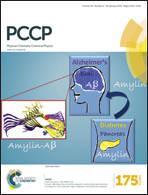A very rapid electronic relaxation process in a highly conjugated Zn(ii)porphyrin–[26]hexaphyrin–Zn(ii)porphyrin hybrid tape†
Abstract
The excited-state energy relaxation processes of a Zn(II)porphyrin–[26]hexaphyrin–Zn(II)porphyrin triply linked hybrid tape, FZn, have been investigated by femtosecond transient absorption spectroscopy (TA), using a directly meso–meso linked hybrid trimer, HZn, as a reference compound. FZn has a very small S1–S0 energy gap through the expansion of π-conjugation and the absorption band at 1897 nm corresponds to its lowest singlet excited-state as a consequence of enhanced transition dipole moment that lies parallel to the long molecular axis. In TA measurements, we observe an energy transfer process (0.4 ps) from the Zn(II)porphyrin moiety to the [26]hexaphyrin core in HZn. In contrast to HZn, a biexponential decay with the time constants of 0.25 and 6.5 ps was observed in the decay profile of FZn. The detailed analysis of excitation wavelength, temperature and solvent dependent TA in FZn revealed that the electronic relaxation process (0.25 ps) from S1 to S0 is faster than the vibrational relaxation processes (5.9 ps) in the excited and ground states due to a very small S1–S0 energy gap through the expansion of π-conjugation. Accordingly, we demonstrate that electronic deactivation overtakes vibrational relaxation processes in a highly conjugated FZn.
![Graphical abstract: A very rapid electronic relaxation process in a highly conjugated Zn(ii)porphyrin–[26]hexaphyrin–Zn(ii)porphyrin hybrid tape](/en/Image/Get?imageInfo.ImageType=GA&imageInfo.ImageIdentifier.ManuscriptID=C5CP07417G&imageInfo.ImageIdentifier.Year=2016)

 Please wait while we load your content...
Please wait while we load your content...